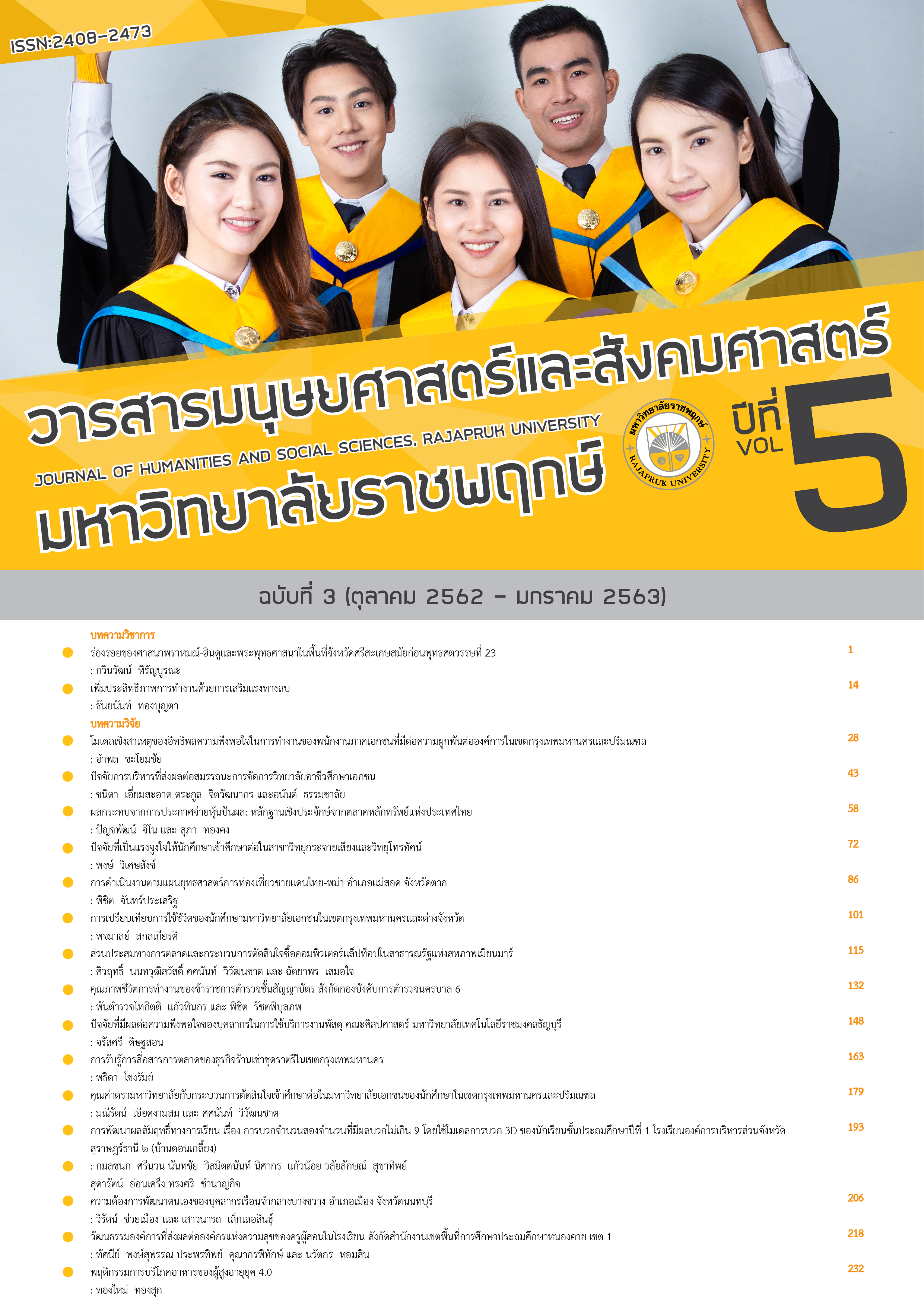The Development of the Mathematics Learning Achievement on Addition of Two Numbers with a Result no More Than 9 by Using 3D Addition Model for Pratomsuksa 1 Students, Suratthani Provincial Administrative Organization School 2 (Bandonkliang)
Main Article Content
Abstract
The objectives of this research were to improve 3D addition model for Pratomsuksa 1 students and to compare the mathematics learning achievement on addition of two numbers with a result no more than 9 between pretest and posttest by using 3D addition model. The sample in the research consisted of 25 students who were studying in Pratomsuksa 1/1 at Suratthani Provincial Administrative Organization School 2 (Bandonkliang), selected by cluster random sampling. There were 3 instruments; 1) 3D addition model 2) 2 lesson plans of addition of two numbers with a result no more than 9 (each lesson plan teaches 50 minutes). 3) 2 the mathematics learning achievement tests of addition of two numbers with a result no more than 9; 15 items of 4 multiple choices and 5 items of matching. All of instruments had its content validity. The data were analyzed to improve 3D addition model by using the efficiency (E1/E2) and analyzed to compare the mathematics learning achievement between pretest and posttest by using t-test for Independent Samples. The research findings showed that: 1) The efficiency of 3D addition model was 90.0/89.8. 2) The mathematics learning achievement on addition of two numbers with a result no more than 9 of posttest by using 3D addition model was higher than pretest significant at .01 levels.
Article Details
References
ณัฐฐาน์ นิธิภัทร์มณีโชค. (2559). บทเรียนคอมพิวเตอร์ช่วยสอน เรื่องระบบหมุนเวียนโลหิต ด้วยเทคโนโลยีเสมือนจริง. วารสารมนุษยศาสตร์และสังคมศาสตร์ มหาวิทยาลัยราชพฤกษ์, 2(2) มิถุนายน – กันยายน 2559: 101 – 112. ค้นเมื่อวันที่ 13 สิงหาคม 2561, จาก https://www.tci-thaijo.org/index.php/rpu/article/view/112417/87603
ณิรดา เวชญาลักษณ์. (2559). การบริหารจัดการชั้นเรียนเพื่อส่งเสริมการเรียนรู้ในศตวรรษที่ 21. วารสารบัณฑิตศึกษา มหาวิทยาลัยราชภัฏสกลนคร, 13(61) เมษายน - มิถุนายน 2559: 11 – 20.
ดิเรก พรสีมา. (2559). ครูไทย 4.0. ค้นเมื่อวันที่ 14 สิงหาคม 2561, จากhttps://www.matichon.co.th/columnists/news_343147.
ทิศนา แขมมณี. (2559). ศาสตร์การสอนองค์ความรู้เพื่อการจัดกระบวนการเรียนรู้ที่มีประสิทธิภาพ. พิมพ์ครั้งที่ 20. กรุงเทพฯ: จุฬาลงกรณ์มหาวิทยาลัย.
ปิยนุช อามาตย์. (2559). การวิจัยและพัฒนาการจัดกิจกรรมการเรียนรู้ด้วยสื่อประสม เรื่อง เศษส่วนกลุ่มสาระการเรียนรู้คณิตศาสตร์ ชั้นประถมศึกษาปีที่ 4. วิทยานิพนธ์ ครุศาสตรมหาบัณฑิต สาขาวิชาวิจัยและประเมินผลการศึกษา คณะครุศาสตร์ มหาวิทยาลัยมหาสารคาม.
วิจารณ์ พานิช. (2555). วิถีสร้างการเรียนรู้เพื่อศิษย์ ในศตวรรษที่ 21. กรุงเทพฯ: มูลนิธิสดศรี-สฤษดิ์วงศ์.
วิทวัส ดวงภุมเมศ และ วารีรัตน์ แก้วอุไร. (2560). การจัดการเรียนรู้ในยุคไทยแลนด์ 4.0 ด้วยการเรียนรู้อย่างกระตือรือร้น. วารสารมนุษยศาสตร์และสังคมศาสตร์ บัณฑิตวิทยาลัย มหาวิทยาลัยราชภัฏพิบูลสงคราม, 11(2) กรกฎาคม - ธันวาคม 2560: 1 – 14.
สถาบันส่งเสริมการสอนวิทยาศาสตร์และเทคโนโลยี. (2555). คู่มือการใช้หลักสูตรกลุ่มสาระการเรียนรู้คณิตศาสตร์ ระดับชั้นประถมศึกษาปีที่ 1 – 3. กรุงเทพฯ: โรงพิมพ์คุรุสภาลาดพร้าว.
สะอิ้งทิพย์ บันเทิงจิตร. (2554). การศึกษาผลสัมฤทธิ์ทางการเรียนวิชาคณิตศาสตร์ เรื่อง “การบวกและการลบจำนวนที่มีผลลัพธ์และตัวตั้งไม่เกิน 100” โดยการใช้สื่อประสมของนักเรียนชั้นประถมศึกษาปีที่ 1 โรงเรียนบ้านรางสะเดา จังหวัดกาญจนบุรี. การศึกษาค้นคว้าอิสระ ศึกษาศาสตรมหาบัณฑิต สาขาการสอนคณิตศาสตร์ มหาวิทยาลัยเกษตรศาสตร์.
Armart, P. (2016). Researching and Developing Instructional Managements with the Mixed Media Method on Fraction Issue though the Mathematics Learning Core for Primary Educational Student at the 4th Grade Level. Thesis, Master of Education in Education Research and Evaluation, Faculty of Education, Mahasarakham Rajabhat University. (in Thai).
Buntengjit, S. (2011). The Study of Mathematics Learning Achievement on “Addition and Subtraction of numbers no more than 100” by Using Multi – Media of Prathomsuksa One Students at Banrangsadao School, Changwat Kanchanaburi. Independent Study, Master of Education in Teaching Mathematics, Department of Education, Kasetsart University. (in Thai).
Chin-on, J., et al. (2015). Role of Instructional Material in Students’ Mathematical Connection. Journal of Education Khon Kaen University, 38(3) July – September: 143 – 151. (in Thai).
Duangpummes, W and Kaewurai, W. (2017). Learning Management in Thailand 4.0 with Active Learning. Humanities and Sciences Journal of Graduate School, Pibulsongkram Rajabhat University, 11(2) July – December: 1 – 14. (in Thai).
Khammani, T. (2016). Brain – Based Learning Models of Teaching. 20th ed. Bangkok: Chulalongkorn University. (in Thai).
Nithipatmaneechock, N. (2016). Computer Assisted Instruction on Circulatory system with an Augmented Reality. Journal of Humanities and Social Sciences, 2(2) June – September: 101 – 112. Retrieved on 13th August 2018, from, https://www.tci-thaijo.org/index.php/rpu/article/view/112417/87603 (in Thai).
Panich, V. (2012). Authentic Learning for 21st Century. Bangkok: Sodsri - Saridwongso Foundation. (in Thai).
Pornsima, D. (2016). Kru Thai 4.0. Retrieved on 14th August 2018, from https://www.matichon.co.th/columnists/news_343147. (in Thai).
The Institute of the Promotion of Teaching Science and Technology. (2012). Mathematics Department Primary 1 – 3 Manual. Bangkok: Kurusapa Printing Ladphrao. (in Thai).
Vadchayaluk, N. (2016). Classroom Management for Supporting Learning in the 21th Century. Journal of Graduation Sakonnakhon Rajabhat University, 13(61) April – July 2016: 11 – 20. (in Thai).


